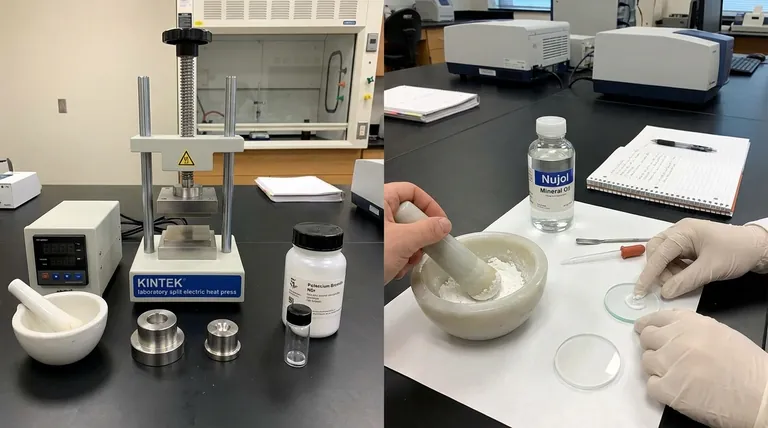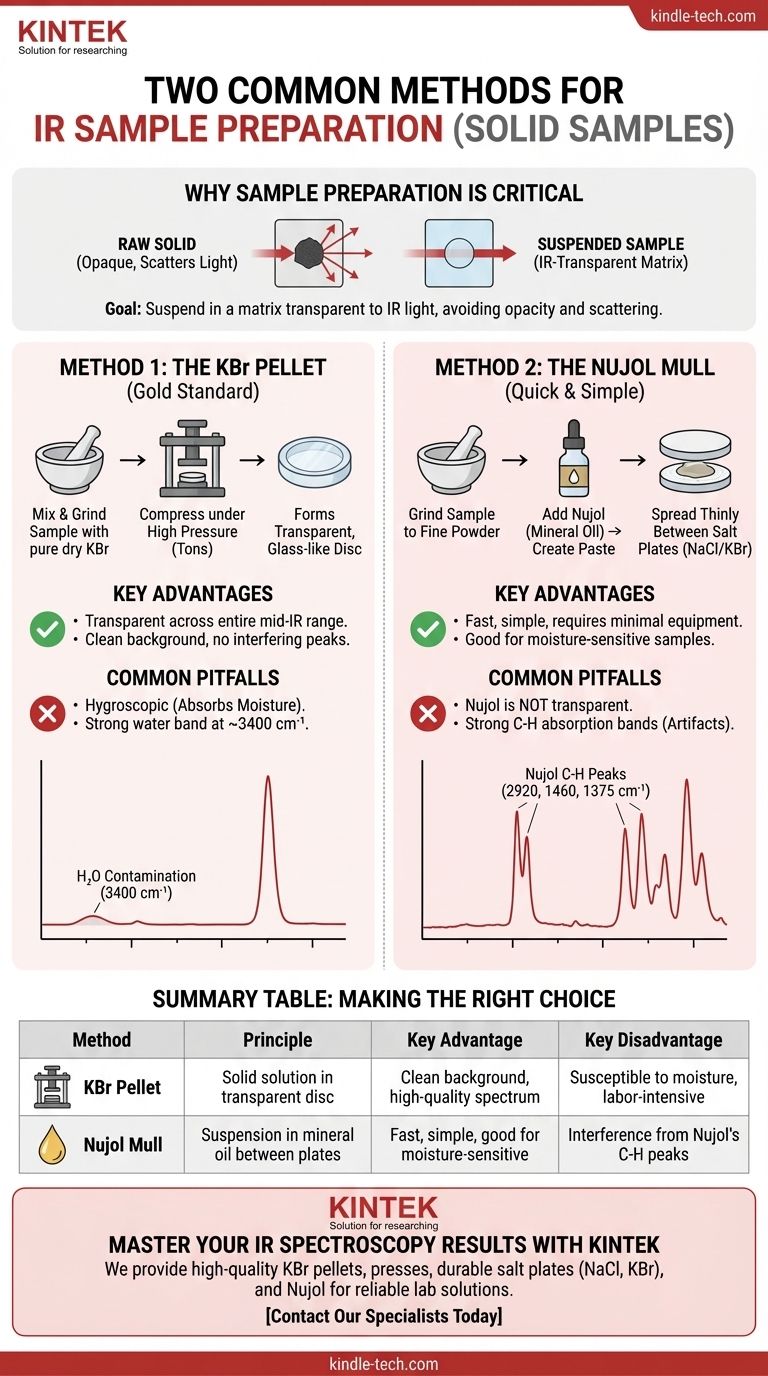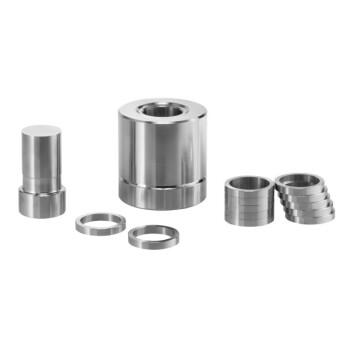For solid samples in infrared (IR) spectroscopy, the two most common preparation methods are the Potassium Bromide (KBr) pellet method and the Nujol mull technique. These methods are designed to suspend a solid analyte in a medium that is transparent to infrared light, allowing the spectrometer to measure the sample's unique absorption spectrum without interference. For liquid samples, the most common approach is the thin-film method.
The core challenge in IR spectroscopy is that most samples, especially solids, are not transparent enough for an infrared beam to pass through them cleanly. The goal of any preparation technique is to suspend your sample in an IR-transparent matrix, ensuring the resulting spectrum is from your compound, not from scattered light or the matrix itself.

Why Sample Preparation is Critical in IR
To obtain a useful IR spectrum, the infrared beam must pass through the sample. However, raw solid or liquid samples present significant obstacles that must be overcome through careful preparation.
The Problem of Opacity and Scattering
Most solid samples in their powdered or crystalline form are opaque to infrared radiation. If you place a raw powder in the spectrometer, most of the IR beam will be reflected or scattered, not transmitted, resulting in a poor or nonexistent spectrum.
The Need for an "IR-Transparent" Window
The solution is to disperse the sample in a substance that is transparent in the mid-infrared range (4000-400 cm⁻¹). This substance, often called a matrix or a mull, holds the sample in the beam's path while not contributing its own absorption peaks to the spectrum.
Method 1: The KBr Pellet
The KBr pellet method is considered the gold standard for producing high-quality spectra from solid samples. It involves mixing the sample with an alkali halide salt, most commonly Potassium Bromide (KBr).
The Principle: Creating a Solid Solution
The goal is to finely grind a very small amount of your solid sample with pure, dry KBr powder. When this mixture is compressed under high pressure (several tons), the KBr fuses to form a thin, transparent, glass-like disc that can be placed directly in the spectrometer's sample holder.
Key Advantages
This method produces a high-quality spectrum because KBr is transparent to IR radiation across the entire mid-IR range. There are no interfering peaks from the matrix material, allowing for a clean view of the sample's true absorption bands.
Common Pitfalls
The primary drawback is moisture contamination. KBr is hygroscopic (it readily absorbs water from the air). Any absorbed water will produce a broad, strong absorption band around 3400 cm⁻¹, potentially obscuring important O-H or N-H stretching vibrations from your sample.
Method 2: The Nujol Mull
The Nujol mull is a simpler, faster alternative to the KBr pellet, particularly useful for samples that are sensitive to moisture or pressure.
The Principle: Creating a Suspension
A mull is prepared by grinding the solid sample into a fine powder and then adding a few drops of a mulling agent, typically Nujol (a brand of mineral oil). This creates a thick paste, which is then spread thinly between two IR-transparent salt plates (often made of NaCl or KBr).
The Role of Nujol
Nujol is a mixture of long-chain hydrocarbons. Its purpose is to surround the finely ground sample particles, reducing the scattering of the IR beam and allowing more light to pass through the sample.
Interpreting the Spectrum
Unlike KBr, Nujol is not transparent across the entire IR range. It has strong C-H absorption bands around 2920, 1460, and 1375 cm⁻¹. An analyst must recognize these peaks and understand that they are artifacts from the mulling agent, not the sample.
Understanding the Trade-offs
Neither method is universally perfect. The choice between them depends on your sample, your equipment, and your analytical goals.
KBr Pellets: Pros and Cons
The primary advantage is the clean background, providing an unobstructed view of the sample's spectrum. However, it is labor-intensive, requires a hydraulic press, and is highly susceptible to water contamination. Furthermore, the high pressure can sometimes alter the crystalline structure of the sample.
Nujol Mulls: Pros and Cons
This technique is fast, simple, and requires minimal equipment. It is excellent for moisture-sensitive compounds. The main disadvantage is the inherent interference from Nujol's own C-H peaks, which can mask important information in those regions of the spectrum.
Making the Right Choice for Your Sample
Your decision should be guided by the nature of your sample and the quality of the data you need.
- If your primary focus is a high-resolution, publication-quality spectrum of a stable solid: The KBr pellet method is the superior choice, provided you take meticulous care to eliminate moisture.
- If your primary focus is a quick, qualitative analysis or your sample is sensitive to moisture: The Nujol mull is the more practical and safer option, but be prepared to disregard the known peaks from the mineral oil.
- If you are analyzing a pure, non-volatile liquid: Use the thin-film method by placing one drop between two salt plates for the most straightforward analysis.
Choosing the correct sample preparation technique is the first and most critical step toward acquiring a meaningful and accurate infrared spectrum.
Summary Table:
| Method | Principle | Key Advantage | Key Disadvantage |
|---|---|---|---|
| KBr Pellet | Create a solid solution in a transparent KBr disc | Clean background, high-quality spectrum | Susceptible to moisture contamination |
| Nujol Mull | Suspend sample in mineral oil between salt plates | Fast, simple, good for moisture-sensitive samples | Interference from Nujol's C-H absorption peaks |
Ready to Achieve Superior IR Spectroscopy Results?
Choosing the right sample preparation method is critical for obtaining accurate, high-quality data. At KINTEK, we specialize in providing the reliable lab equipment and consumables you need to master these techniques.
We provide the tools for success:
- High-quality KBr pellets and presses for pristine, publication-ready spectra.
- Durable salt plates (NaCl, KBr) and Nujol for fast, effective mull preparations.
Let our expertise support your laboratory's needs. Contact our specialists today to find the perfect solution for your IR spectroscopy workflow and ensure your analyses are a success.
Visual Guide

Related Products
- Laboratory Hydraulic Press Split Electric Lab Pellet Press
- kbr pellet press 2t
- Automatic Laboratory Hydraulic Press for XRF & KBR Pellet Press
- Automatic Laboratory Hydraulic Pellet Press Machine for Lab Use
- Laboratory Manual Hydraulic Pellet Press for Lab Use
People Also Ask
- What is the purpose of KBr pellets? Unlock Clear FTIR Analysis of Solid Samples
- What is an example of a hydraulic press? Discover the Power of Laboratory Sample Preparation
- How much pressure can a hydraulic press make? From 1 Ton to 75,000+ Tons of Force
- Why do we use KBr in FTIR? The Key to Clear, Accurate Solid Sample Analysis
- What is the use of potassium bromide in IR? Achieve Clear Solid Sample Analysis with KBr Pellets



















